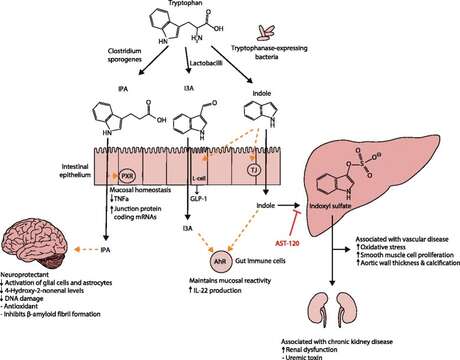Microbiota-derived 3-Indolepropionic acid

Açıklama:
: Several vector versions of this file are available. File:API → File:Microbiota-derived 3-Indolepropionic acid.svgFile:Microbiota-derived 3-Indolepropionic acid-notext.svg For more information, see Help:SVG. In other languages. Alemannisch ∙ العربية ∙ беларуская (тарашкевіца) ∙ български ∙ বাংলা ∙ català ∙ нохчийн ∙ čeština ∙ dansk ∙ Deutsch ∙ Ελληνικά ∙ English ∙ British English ∙ Esperanto ∙ español ∙ eesti ∙ euskara ∙ فارسی ∙ suomi ∙ français ∙ Frysk ∙ galego ∙ עברית ∙ hrvatski ∙ magyar ∙ հայերեն ∙ Bahasa Indonesia ∙ Ido ∙ italiano ∙ 日本語 ∙ ქართული ∙ 한국어 ∙ lietuvių ∙ македонски ∙ മലയാളം ∙ Bahasa Melayu ∙ norsk bokmål ∙ Plattdüütsch ∙ Nederlands ∙ norsk nynorsk ∙ norsk ∙ occitan ∙ polski ∙ português ∙ português do Brasil ∙ română ∙ русский ∙ sicilianu ∙ Scots ∙ slovenčina ∙ slovenščina ∙ српски / srpski ∙ svenska ∙ தமிழ் ∙ ไทย ∙ Türkçe ∙ татарча/tatarça ∙ українська ∙ vèneto ∙ Tiếng Việt ∙ 中文(简体) ∙ 中文(繁體) ∙ +/−. : . Description: English: This diagram shows the metabolism of tryptophan to indole and indole derivatives in the colonic lumen. Clostridium sporogenes metabolizes indole into 3-indolepropionic acid (IPA), a highly potent neuroprotective antioxidant. In the intestine, IPA binds to pregnane X receptors (PXR) in intestinal cells, thereby facilitating mucosal homeostasis and barrier function. Following absorption and distribution to the brain, IPA confers a neuroprotective effect against cerebral ischemia and Alzheimer’s disease. Lactobacillus species metabolize indole into indole-3-aldehyde (I3A) which acts on the aryl hydrocarbon receptor (AhR) in intestinal immune cells, in turn increasing interleukin-22 (IL-22) production. AhR activation markedly affects in gut immunity by supporting epithelial barrier function, increasing immune tolerance to commensal microbiota, and protecting against pathogenic infections. Indole itself acts as a glucagon-like peptide-1 (GLP-1) secretagogue in intestinal L cells and as a ligand for AhR. Indole can also be metabolized by the liver to indoxyl sulfate, a compound that is detrimental to human health in high concentrations. Accumulation of indoxyl sulfate in blood plasma is toxic and associated with vascular disease and renal dysfunction. AST-120 (activated charcoal), an intestinal sorbent that is taken by mouth, adsorbs indole, in turn decreasing the concentration of indoxyl sulfate in blood plasma. Date: 21 April 2016. Source: (April 2016). "Microbial metabolism of dietary components to bioactive metabolites: opportunities for new therapeutic interventions". Genome Med 8 (1): 46. DOI:10.1186/s13073-016-0296-x. PMID 27102537. PMC: 4840492. Figure 1: Molecular mechanisms of action of indole and its metabolites on host physiology and disease. Author: Zhang LS, Davies SS.
Aşağıdaki Sayfalarda Bulunmaktadır:
Bu resim hiçbir koleksiyonda yer almıyor.
Kaynak Bilgileri
- lisans
- cc-by-3.0
- telif hakkı
- Zhang LS, Davies SS
- oluşturan
- Zhang LS, Davies SS
- kaynak
- (April 2016). "Microbial metabolism of dietary components to bioactive metabolites: opportunities for new therapeutic interventions". Genome Med 8 (1): 46. DOI:10.1186/s13073-016-0296-x. PMID 27102537. PMC: 4840492. Figure 1: Molecular mechanisms of action of indole and its metabolites on host physiology and disease
- orijinal
- orijinal medya dosyası
- kaynağı ziyaret et
- ortak site
- Wikimedia Commons
- ID


